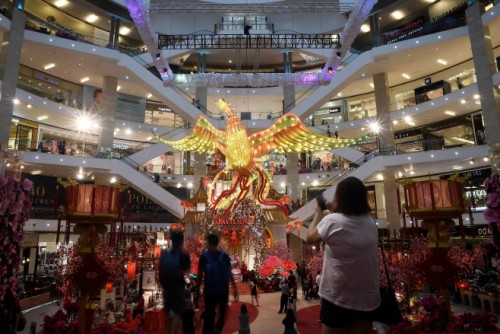 A shopping mall in Kuala Lumpur, Malaysia adorned itself with Chinese New Year decorations on Jan. 11./ Source: AFP, Yonhap News A shopping mall in Kuala Lumpur, Malaysia adorned itself with Chinese New Year decorations on Jan. 11./ Source: AFP, Yonhap News |
By AsiaToday reporter Jina Koh – Young spenders in China and India are emerging as the saviors of future trade wars.
The inauguration of U.S. President Donald Trump is expected to bring a wave of trade protectionism, but consumerism in both China and India is likely to bring economic stability.
Trump has been blaming China for manipulating its currency without opening trade while making the country a major target of his trade protectionism. India can't be free from this war, either. Since most of the pharmaceutical products sold in the United States are produced in India, they will be inevitably regulated in future trade with the U.S..
In the meantime, spending pattern changes and rising incomes in these two countries are emerging as powerful weapons of economic growth.
Global consulting firm Deloitte took notice of consumer booms driven by young consumers in both countries in its recently released report titled "Voice of Asia." Mass consumption is increasing as these countries are switching toward consumption-driven economies. "We are seeing a transition of the growing middle class in very large economies such as China and India, where consumers are coming to the fore," Ric Simes, economist at Deloitte, told CNBC on Friday.
In fact, China has entered a phase to maintain growth rate at the 6 percent level. China's economy grew by 6.7% in 2016, the lowest in 26 years, said China's National Bureau of Statistics on Friday. This implies two things: one is that investment by state-owned enterprises will decrease, and another thing is that consumer spending will increase to become the main growth driver.
In particular, young people are the main growth drivers. Accounting for a quarter of the total population, Chinese Millennials spent nearly 4 trillion yuan (about US$580 billion) in 2015 owing to stimulation of consumption through Omnichannel. They are being called "Omnichannel Spenders," as they have become the most important customers of Omnichannel, which integrates the shopping experience through all devices online and offline. Forbes predicted that they will account for 80% of total consumer spending growth, spending about $25 trillion, over the next decade.
The reason for their popularity is that with several decades of double-digit growth behind them, they are willing to embrace changed consumer spending, that is to say credit, consumption, and debt. Those Chinese aged over 70 are accustomed to living frugally, and those middle-aged are spending a lot of their savings on real estate while looking after their own parents. But the younger generation is optimistic about their future incomes, and they are willing to spend more.
In India, the economy led by young and tech savvy consumers has reached a significant level. Indian consumers spent 59.6% of gross domestic product in 2015, compared with 37% in China during the same period, according to World Bank data. This is comparable to that of the United States and the United Kingdom (68.1% and 65.1%, respectively), which is relatively higher than other Asian emerging economies.
One of the major reasons for this will be demographic changes. As the number of people moving to the city increased, the number of nuclear family increased and the consumption pattern changed. In particular, the generation of the 1990s faces a variety of consumption choices. As a result, they are more willing to spend than their parents, and this has become a new norm.
Mobile devices are the major tools that spread the generation's consumption. A recent survey conducted by eMarketer showed a strong preference for mobile apps among young adults in India. 94% of respondents said apps were more convenient than mobile websites, and 83% had used their mobile phones to do some online shopping. The number of smartphone users in the country is expected to reach 267.1 million this year, up 19.5% in 2016. The Economist estimated that about 1 billion Indians will go online by 2030.
#China #India #Millennials #spender #consumerism
Copyright by Asiatoday
Most Read
-
1
-
2
-
3
-
4
-
5
-
6
-
7





















